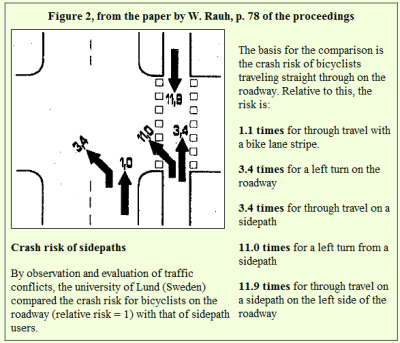A study released this week by the Harvard School of Public Health may reignite the discussion over the safety of cycle tracks for bicycling through urban areas.
The Harvard study, conducted on six cycle tracks in Montreal, found that risk of injury for bicyclists is somewhat less in the physically separated bike lanes than riding in the street.
Those findings run counter to previous studies that cycle tracks are more dangerous for bicyclists, especially at intersections [see John S. Allen helmetcam video at left showing hazards on a Montreal cycle track].
The Harvard report could come into play as urban planners search for types of bicycle facilities that encourage more people to ride their bicycles for commuting and running errands. The San Francisco Bicycle Coalition, for instance, is pushing for 100 miles of separated bike lanes (see video below).
Uncommon in US
Cycle tracks are bicycle lanes that are physically separated from traffic by curbs, parked cars, vegetation or other barriers. They are more common in European countries than the US, where their use has been limited essentially to New York City; Washington, DC, Portland, Oregon; St. Petersburg, Fla. and San Francisco.
According to the Harvard study released in Injury Prevention magazine on Wednesday, most people prefer to ride their bicycles separated from traffic. It cites that cycle tracks are discouraged in the US “by engineering guidance that suggests that facilities such as cycle tracks are more dangerous than the street.”
Injury risk
Setting out to study this belief, the Harvard researchers chose six cycle tracks in Montreal and compared vehicle-bicycle crashes and injury reports to similar reference streets. Then they calculated the relative risk of injury:
“Overall, 2.5 times as many cyclists rode on cycle tracks compared with reference streets and there were 8.5 injuries and 10.5 crashes per million bicycle-kilometres.
“The RR (relative risk) of injury on cycle tracks was 0.72 (95% CI 0.60 to 0.85) compared with bicycling in reference streets. These data suggest that the injury risk of bicycling on cycle tracks is less than bicycling in streets. The construction of cycle tracks should not be discouraged.”
Dangerous junctions
Other reports over the years have shown the opposite to be true, especially at intersections.
 John S. Allen cites a 1990 study (diagram at left) from Europe at his Bicycle Facilities, Laws and Programs Pages. It finds that cyclists face at least three times the crash risk at intersections on cycle tracks than riding in the street. Making left turns from cycle tracks or riding against the flow of motor vehicle traffic increases the risk.
John S. Allen cites a 1990 study (diagram at left) from Europe at his Bicycle Facilities, Laws and Programs Pages. It finds that cyclists face at least three times the crash risk at intersections on cycle tracks than riding in the street. Making left turns from cycle tracks or riding against the flow of motor vehicle traffic increases the risk.
One reason is that there are three or four intersecting networks — motor vehicle traffic lanes, cycle tracks, sidewalks for pedestrians and possibly even a bus lane — all converging at the same location.
More research on cycle tracks has been collected in the UK by John Franklin, who says “little evidence has been found to suggest that cyclists are safer on paths than on roads.”
There's no way to know how this controversy will play out, but it looks like a worthwhile area for more study.
Here are a couple of other articles about cycle tracks (thanks to Michael):
“They're likely safer and much more comfortable….”
“Copenhagen comes to New York?”

Recent Comments